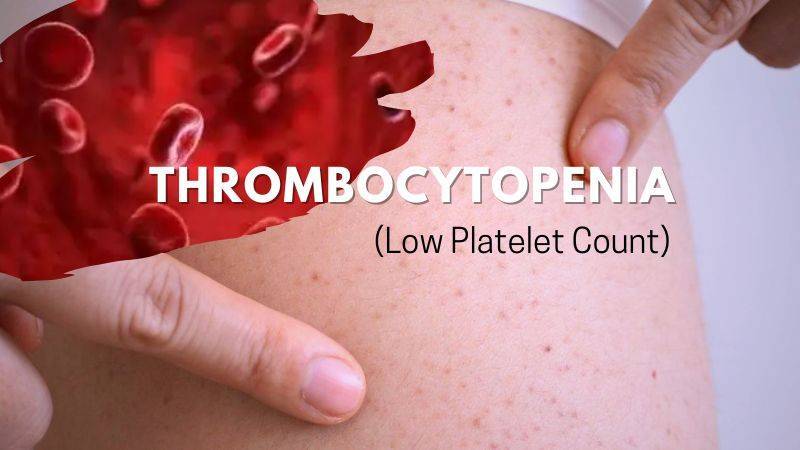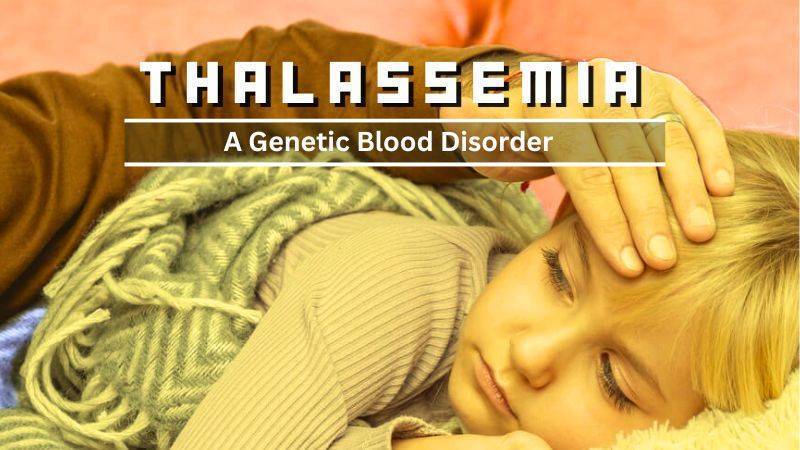Definition | Significance | Causes | Symptoms | Diagnosis | Treatment | Prevention | Expectations |
A reduced platelet count can impair your blood’s clotting capability. This could potentially lead to unregulated bleeding, necessitating urgent medical intervention in some cases.
For the majority of individuals, it doesn’t pose a significant concern. However, in severe cases, spontaneous bleeding can occur in the eyes, gums, or bladder, or excessive bleeding might follow an injury.
What is Thrombocytopenia?
Thrombocytopenia is when there are fewer than the usual number of platelets in the blood.
Platelets, also known as thrombocytes, play a crucial role in blood clotting and wound healing.
The normal platelet count is typically between 150,000 and 450,000 platelets per microliter of blood. A count below 150,000 is generally considered Thrombocytopenia.
What does a Low Platelet Count signify?
Blood is comprised of various types of cells suspended in a liquid known as plasma. These blood cells include:
- Red blood cells
- White blood cells
- Platelets (also referred to as thrombocytes)
Platelets aggregate and form clots to arrest bleeding when your skin sustains an injury or rupture. However, when platelets in your blood are insufficient, your body’s ability to form clots becomes compromised.
This deficiency of platelets is termed thrombocytopenia. Depending on its root cause, this condition can vary from being mild to severe.
Some individuals with thrombocytopenia may not exhibit any symptoms; however, in severe cases, uncontrolled bleeding can be fatal.
A multitude of factors can induce thrombocytopenia, including pregnancy, medical conditions like leukemia, or certain medications such as anticoagulants.
Causes of Thrombocytopenia

It can be caused by a variety of factors, including:
- Decreased platelet production: Conditions such as leukemia, certain types of anemia, viral infections (like Hepatitis C or HIV), chronic alcohol use, and chemotherapy can reduce platelet production in the bone marrow.
- Increased platelet destruction: This can happen in the bloodstream (intravascular) or in the spleen or liver (extravascular). Conditions such as immune thrombocytopenia or idiopathic thrombocytopenic purpura (ITP), thrombotic thrombocytopenic purpura (TTP), disseminated intravascular coagulation (DIC), and certain infections can lead to increased destruction of platelets.
- Splenic sequestration: The spleen can hold up to a third of the body’s platelets. In certain conditions like cirrhosis or lymphomas, the spleen can enlarge and hold too many platelets, reducing the number available in circulation.
Warning Signs of Thrombocytopenia

The manifestation of thrombocytopenia symptoms largely depends on the severity of your platelet deficiency.
In case of a low platelet count, you might notice:
- Bruises that appear red, purple, or brown, known as purpura
- A rash with tiny red or purple spots, referred to as petechiae
- Nosebleeds
- Gums that bleed
- Prolonged or unstoppable bleeding from wounds
- Heavy menstrual bleeding
In instances of severe thrombocytopenia, internal bleeding may occur. This can be detected through:
- Blood in your stool
- Blood in your urine
- Vomiting blood or vomit that appears very dark
Should you notice any indications of internal bleeding, it’s crucial to seek medical help immediately.
In rare circumstances, thrombocytopenia may precipitate bleeding in the brain. If you suffer from a low platelet count and experience headaches or neurological issues, it’s advisable to consult a healthcare professional promptly.
Thrombocytopenia Diagnosis
Physical Examination
If a low platelet count is suspected, your doctor will commence with a physical exam. They will inspect your body for any abnormal bruising or presence of petechiae (tiny red and purple spots), an indication of capillary bleeding frequently associated with low platelet count.
Additionally, your doctor might examine your abdomen to detect an enlarged spleen or liver.
Medical History
The doctor may also inquire about:
- Family history of bleeding disorders
- Medications and herbal supplements you are taking
- Your dietary habits
- Alcohol consumption and intravenous drug use
- Current methods of sexual protection
This information can help your healthcare provider effectively manage your condition if you are diagnosed with a low platelet count.
Diagnostic Tests
A variety of blood, bone marrow, and ultrasound tests can assist your doctor in diagnosing this condition and identifying its root cause.
Blood Tests
To confirm a low platelet count, your doctor will conduct a complete blood count (CBC) test, typically requiring a simple blood draw from your arm.
A CBC test evaluates the count of different types of cells in your blood. It will indicate if your platelet count is lower than normal.
Your doctor might also opt for a blood smear test, which examines your blood under a microscope to assess the platelets’ appearance.
Your blood may also be checked for platelet antibodies, proteins that destroy platelets. Certain drugs like heparin or unknown factors can trigger the production of platelet antibodies.
Your doctor might also order blood-clotting tests such as partial thromboplastin time and prothrombin time. These tests involve adding certain chemicals to a blood sample to measure how long it takes for your blood to clot.
Ultrasound
If an enlarged spleen is suspected, your doctor may order an ultrasound. This imaging technique uses sound waves to generate a visual representation of your spleen.
Bone Marrow Aspiration and Biopsy
Your doctor may also conduct a bone marrow test. These tests come in two forms:
- a biopsy
- an aspiration
and sometimes both may be conducted concurrently.
During bone marrow aspiration, a small quantity of bone marrow is extracted from one of your bones.
A bone marrow biopsy involves removing a sample of your core bone marrow, typically from the hip bone.
Treatment

The approach to treating a low platelet count can be diverse. The right treatment for low platelets is determined by your healthcare provider or specialist, depending on the cause and severity of your condition.
In mild cases, monitoring without active intervention might be the preferred route by your doctor.
However, if your platelet deficiency is more severe, medical treatment may become necessary. Potential treatment options can comprise:
- Blood or platelet transfusions
- Altering medications that might be causing a decrease in platelet count
- Administration of steroids, immune globulin, or other immunosuppressive medications
- Surgery for spleen removal
When treatment is needed, the goal is to increase your platelet count to help prevent serious bleeding in the stomach or brain.
If you are bleeding very badly, have very few platelets without any symptoms, or if you are pregnant, you might need a platelet transfusion.
Some people start treatment when they begin to feel unwell, while others might need treatment even if they feel fine, just to prevent sudden, unexpected bleeding.
Prevention
There can be many reasons your doctor may check for a low platelet count. Sometimes, a regular blood test may show your levels are low.
If you have a high chance of getting a low platelet count due to a disease or past health problems, your doctor may advise you to take steps to prevent it. This might include:
- Staying away from activities where you could get hurt and bleed or get a bruise (like playing rough sports)
- Drinking less alcohol
- Changing what you eat
- Stopping or changing medicines that can lower platelets, like aspirin and ibuprofen
- Getting certain shots to prevent disease
- Staying away from harmful chemicals
Expectations
Having a low platelet count might seem frightening, but there are many ways to stop it from happening and to treat it. Sometimes, all you need to do is keep an eye on it.
But some people with low platelets do need treatment. Often, fixing the problem causing the low platelet count is enough.
If you have low platelets or could get them, your doctor can help you make a plan to prevent or treat it.
Take Care of yourself!
Also Read






